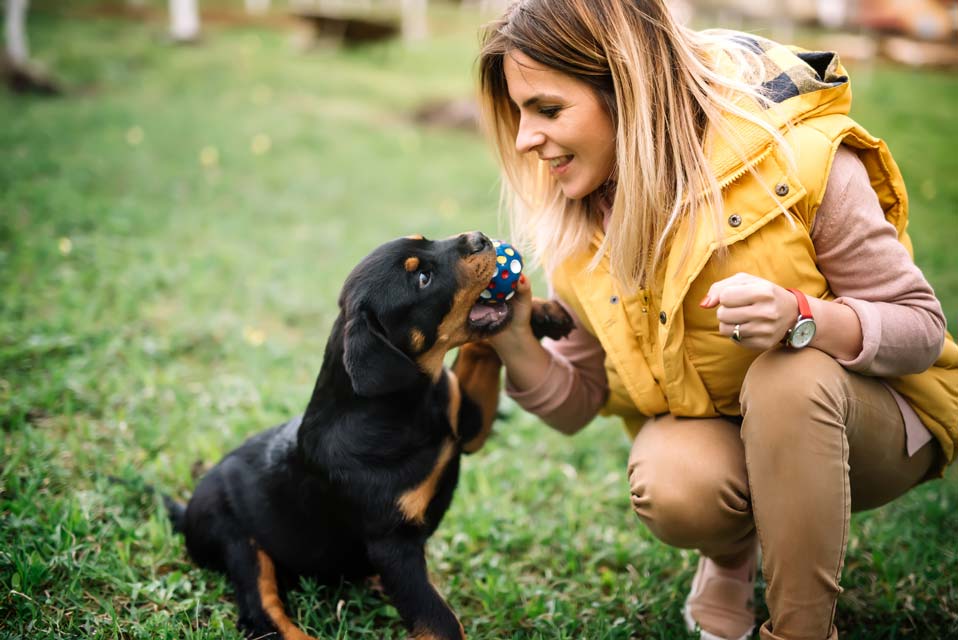How to Teach Your Dog the Drop Command

One of the essential commands all dogs should learn is drop. Not only will this help the two of you play fetch easier, but it will also increase your dog's safety. Dogs often like to pick up, chew on, lick, and swallow things they shouldn't, and the drop command might mean the difference between life and death if your dog grabs something dangerous and you're too far away to get it out of her mouth.
Preparing to Teach the Drop Command
Here are some basic steps to follow when preparing to train your dog the drop command:
- The first step in teaching a dog to drop something is to choose the words you're going to use for the command. One or two words are easiest for a dog to learn, so "drop," "drop it," "release," or "leave it" can all work well.
- Next, pick out a toy that your dog really loves. It should be small and comfortable for the dog to hold in her mouth.
- Gather some treats to help with your training session. Make sure they aren't too large—break them into small, tasty morsels if they are. You might wish to use pieces of your dog's regular kibble. Whatever you choose, try to pick something the dog likes more than the toy you've chosen but be sure it's safe for dogs. It can also help to schedule the training session when you know your dog is hungry.
- When you're first starting out, choose a confined, quiet space without distractions in which to work with your dog. Once she's learned the command, you should practice it with distractions around to ensure she'll follow it in all situations.
A clicker can help your dog learn commands faster. Learn more here: "Clicker Training for Dogs: An Overview."
- Don't train for too long at once. Generally, ten minutes at a time is a good length for dog training. You can do two or three short sessions a day.
- Have a play session before the training session to get your dog's excess energy out. That will help the training go smoother.
- It might help to have your dog on a leash in the early stages of teaching the drop command. That way, she can't grab the toy and take off with it.
Steps for Training the Drop Command
Once you're ready to do a training session for the drop command, follow these steps:
- Offer your dog the toy and get her to take it in her mouth.
- Once she has the toy in her mouth, give your dog the command you've chosen for drop and simultaneously offer her a treat. Say the command the exact same way every time.
- Don't repeat the command more than a couple of times. Put the treat right in front of your dog's nose. If she doesn't drop the toy to take it, you may need to choose a different type of treat for the training or try again when your dog is hungry.
- Give your dog praise as well as the treat as soon as she drops the toy.
While training the drop command, you should only use items that are appropriate for your dog to pick up and chew. Eventually, of course, you want her to respond to the command when she's holding something inappropriate in her mouth, but you don't want to use those items for training.
- If you're using a clicker, click it at the exact moment that your dog releases the toy, so she learns to connect the command with the action of dropping what's in her mouth.
- Repeat this until your dog is consistently dropping the toy when you give the command.
- Over time, as your dog is doing well learning, move further away from her when you give the drop command.
- Once your dog is consistently responding correctly to the drop command, add some distractions, practice outside, or use a toy she likes even better.
- Eventually, practice the drop command without giving your dog a treat every time. Give treats sporadically so she never knows if she'll be getting one.
Remember, always stay positive when training your dog. Negative reinforcement, including yelling and physical punishment when she isn't doing what you want, doesn't work well and can damage your relationship. Instead, only do training sessions when you feel patient, keep them short to allow your dog to be successful, and give positive reinforcement as your dog makes progress in the right direction.
If it doesn't seem to be going well, try using a less well-loved toy and/or a tastier treat to help things go smoother.
You May Also Like These Articles:
Clicker Training for Dogs: An Overview
How to Teach a Dog to Lie Down
Disclaimer: This website is not intended to replace professional consultation, diagnosis, or treatment by a licensed veterinarian. If you require any veterinary related advice, contact your veterinarian promptly. Information at DogHealth.com is exclusively of a general reference nature. Do not disregard veterinary advice or delay treatment as a result of accessing information at this site. Just Answer is an external service not affiliated with DogHealth.com.
Notice: Ask-a-Vet is an affiliated service for those who wish to speak with a veterinary professional about their pet's specific condition. Initially, a bot will ask questions to determine the general nature of your concern. Then, you will be transferred to a human. There is a charge for the service if you choose to connect to a veterinarian. Ask-a-Vet is not manned by the staff or owners of DogHealth.com, and the advice given should not delay or replace a visit to your veterinarian.



